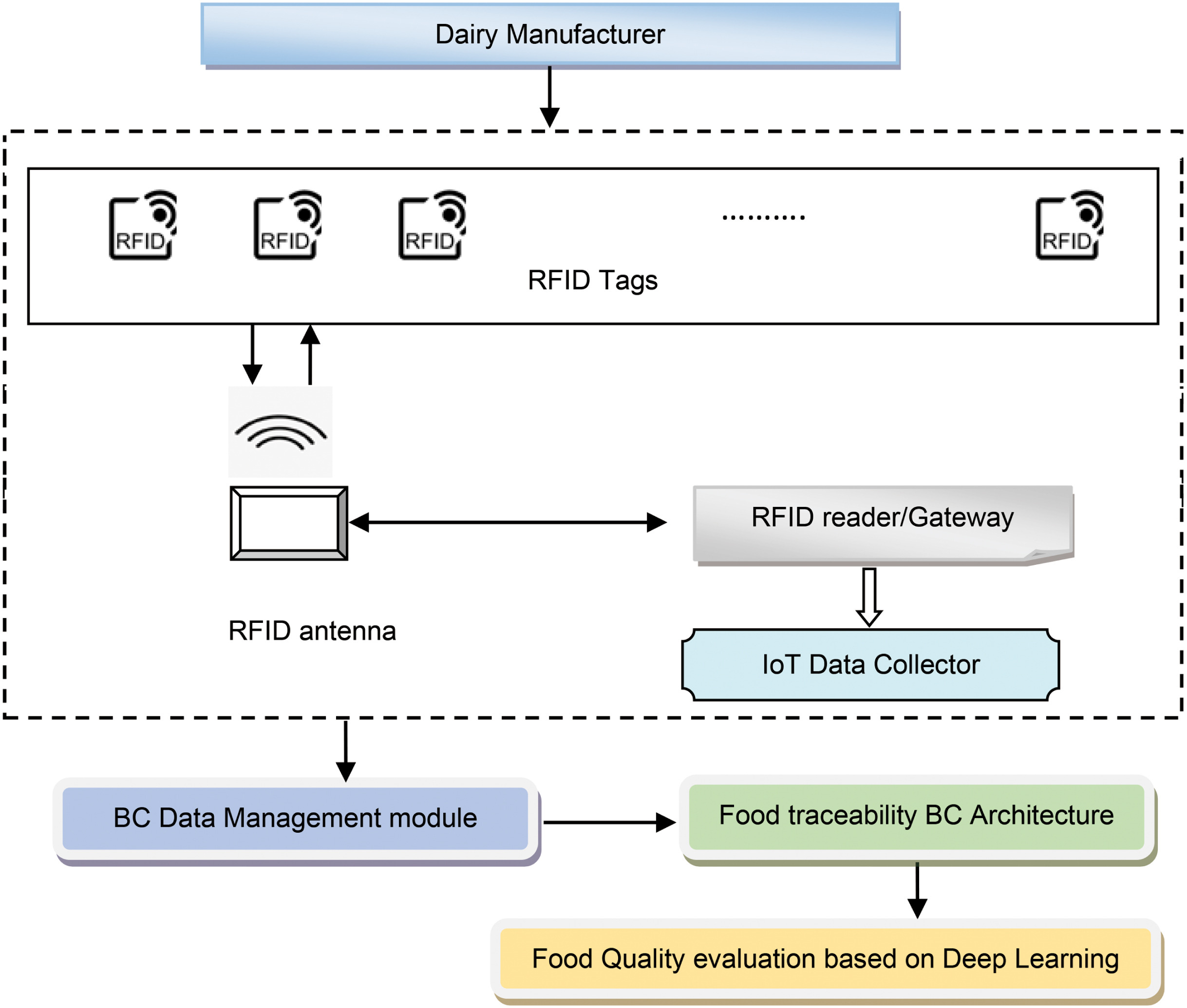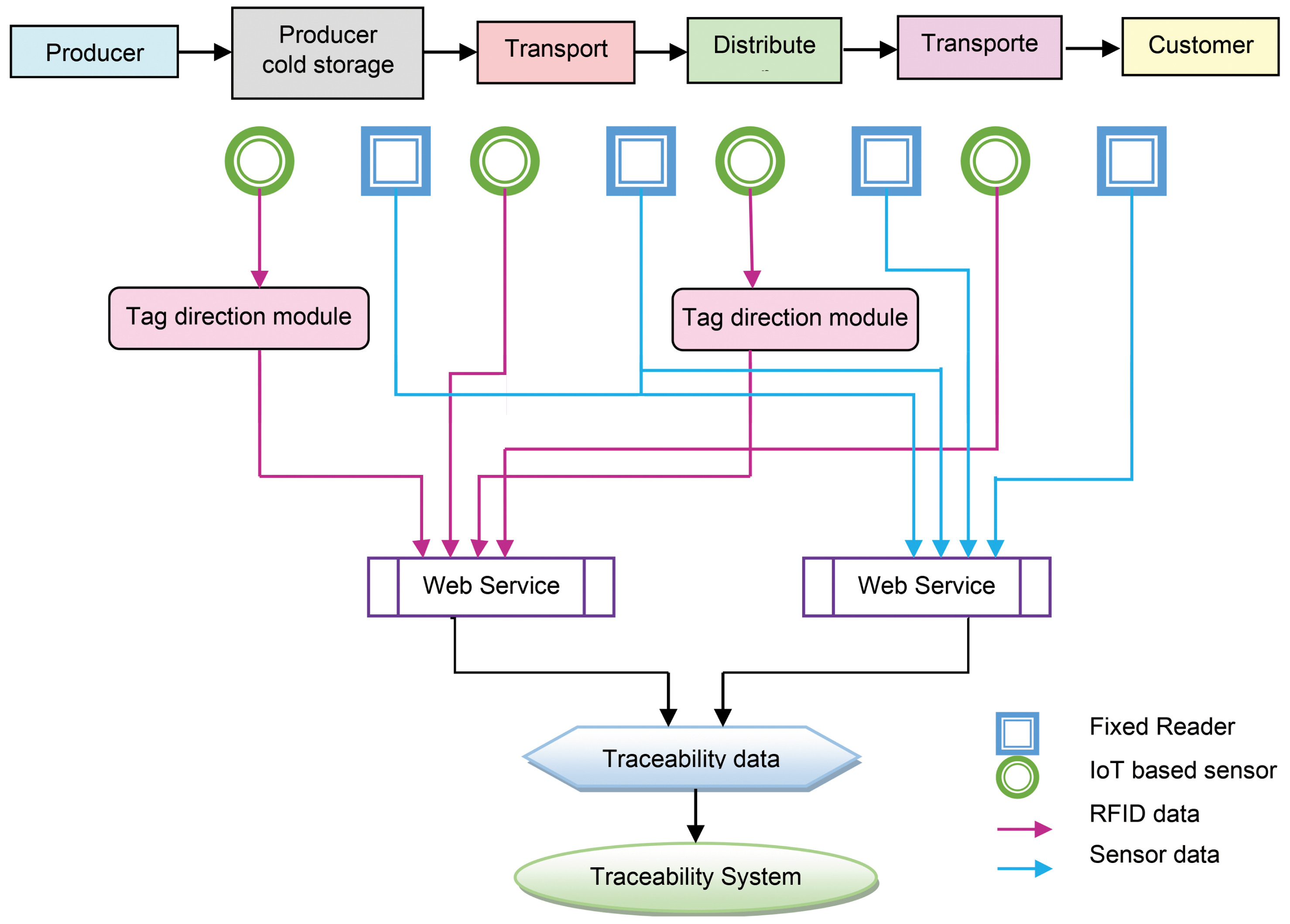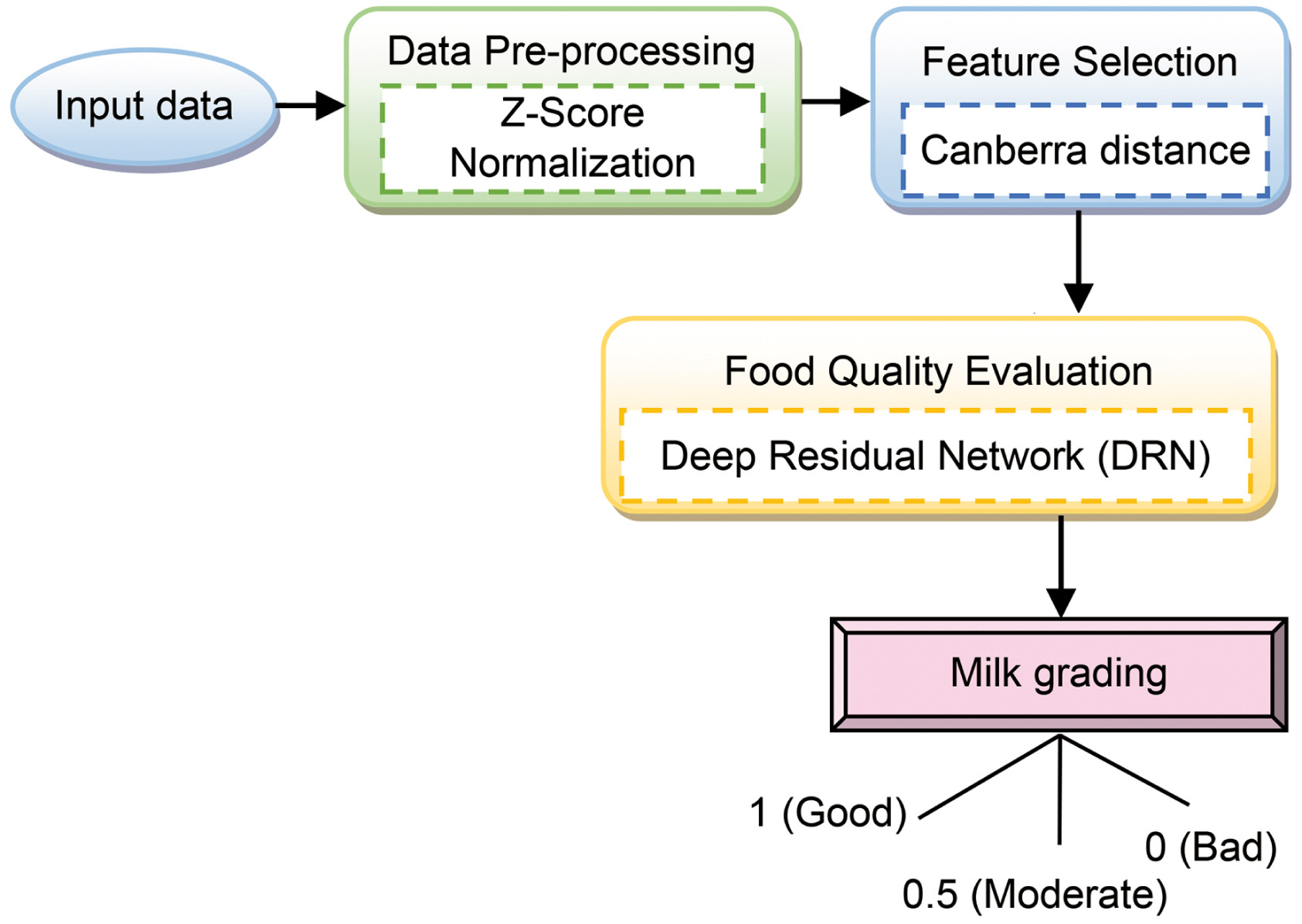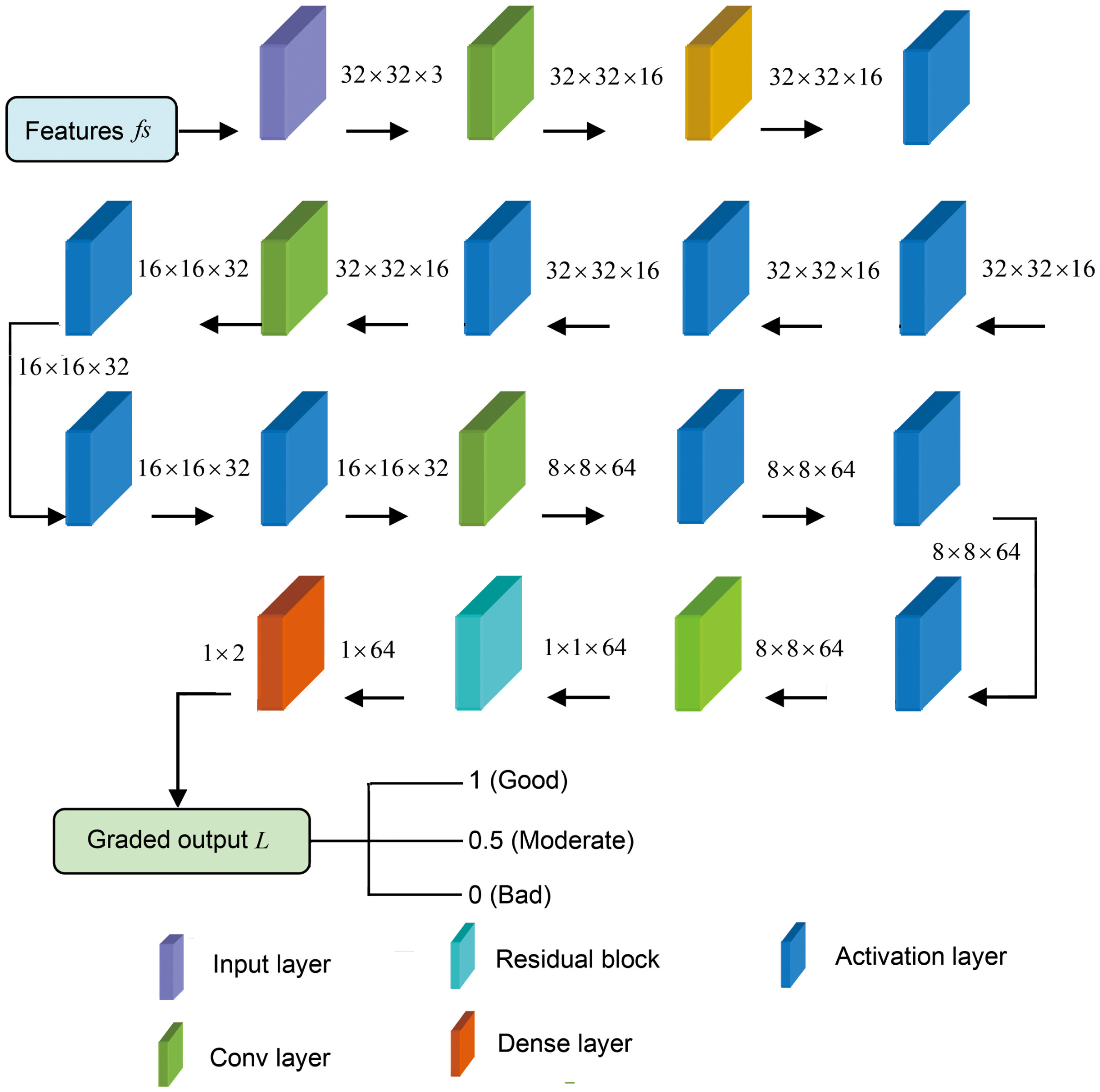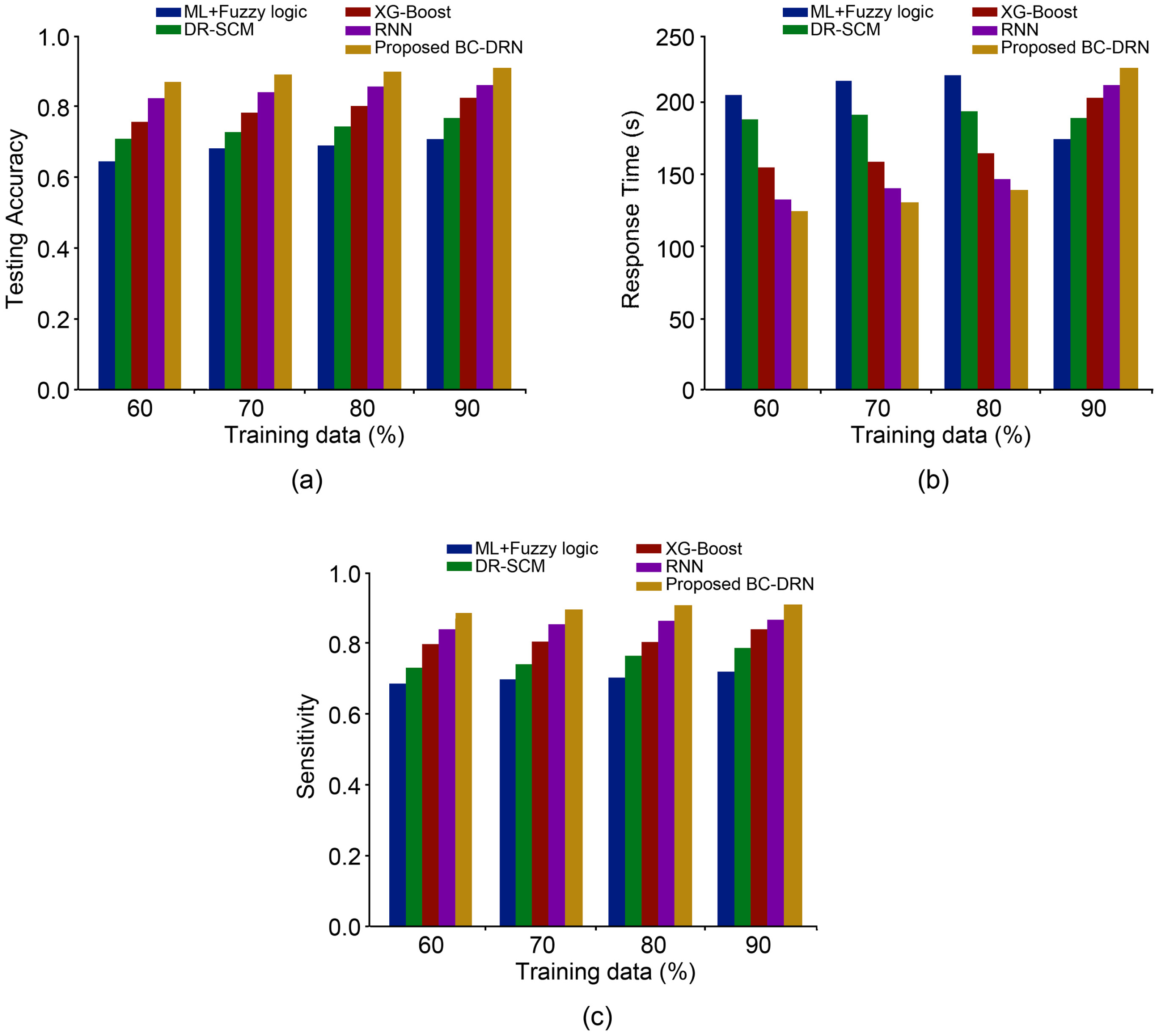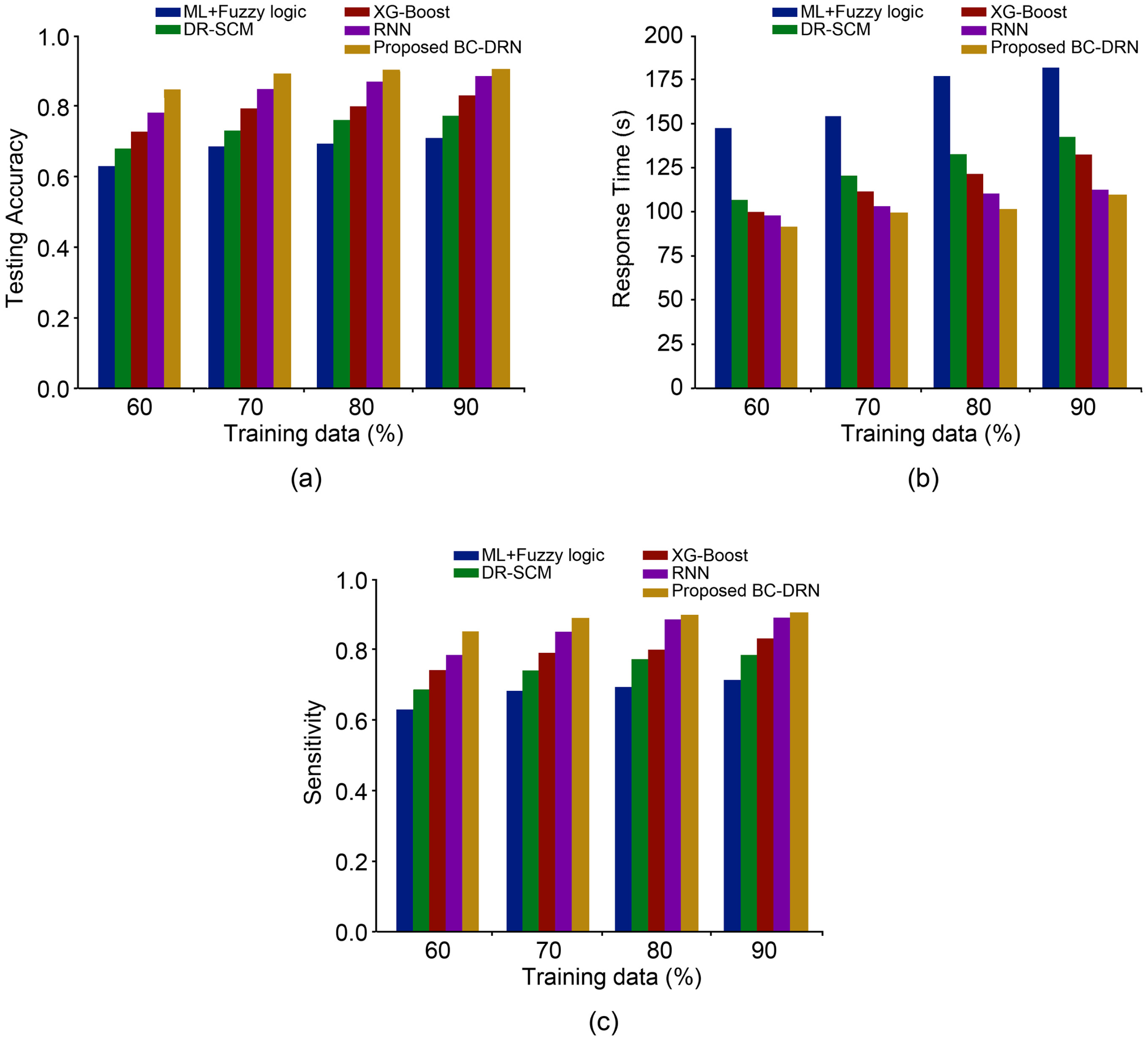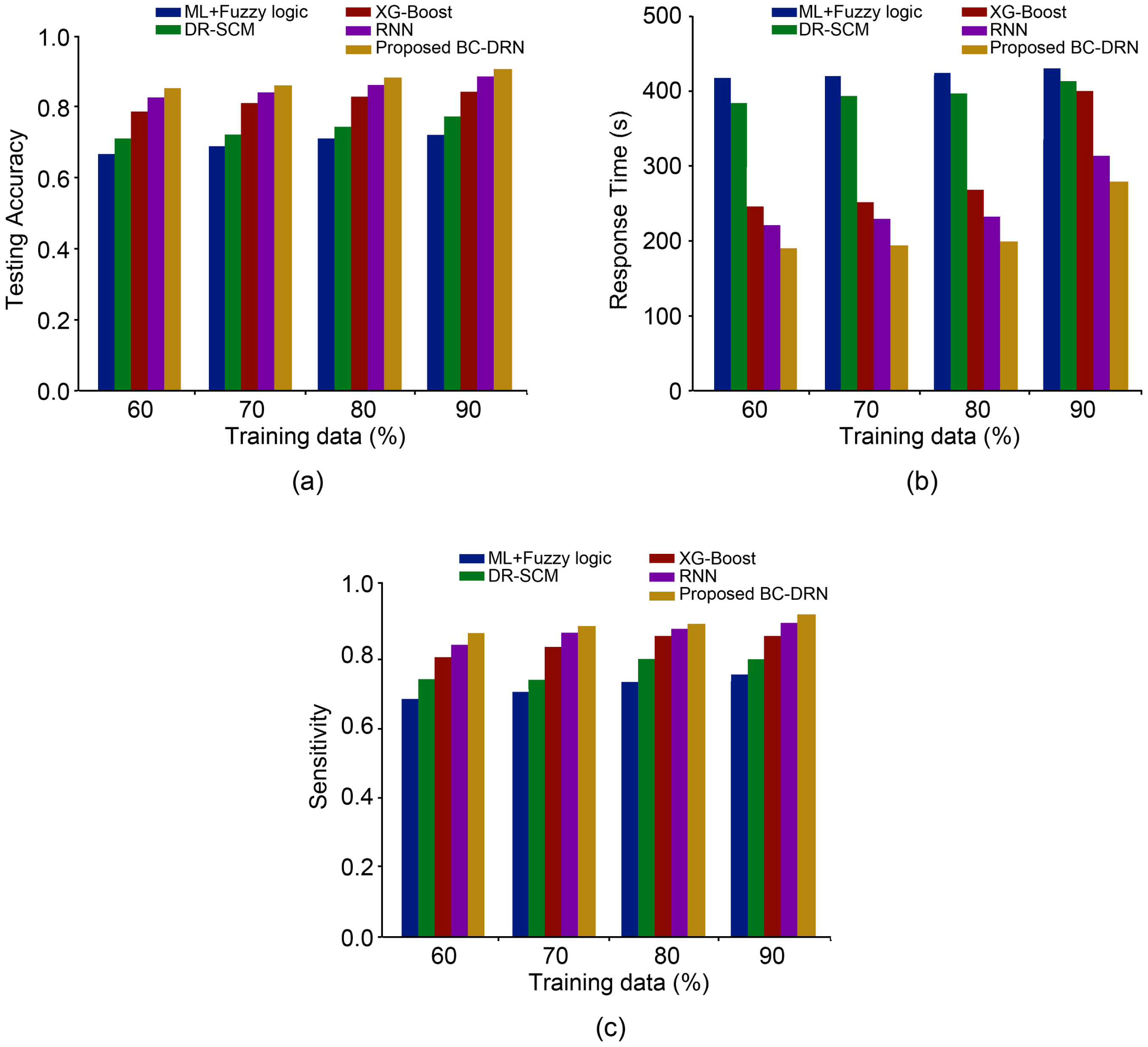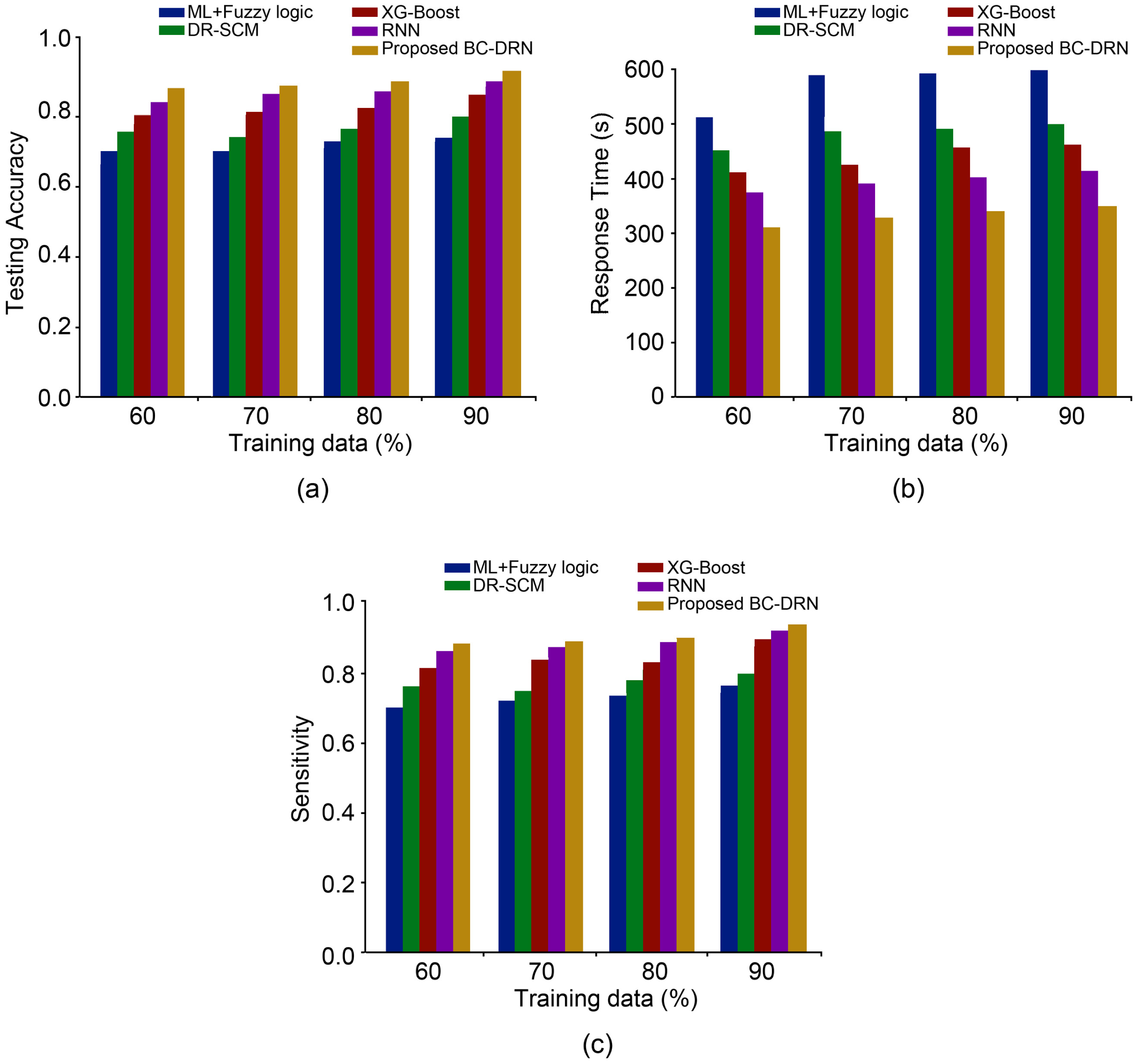Journal:A blockchain-driven IoT-based food quality traceability system for dairy products using a deep learning model
| Full article title | A blockchain-driven IoT-based food quality traceability system for dairy products using a deep learning model |
|---|---|
| Journal | High-Confidence Computing |
| Author(s) | Manisha, Noothi; Jagadeeshwar, Madiraju |
| Author affiliation(s) | Chaitanya Deemed to be University |
| Primary contact | noothimanisha6 at gmail dot com |
| Year published | 2023 |
| Volume and issue | 3(3) |
| Article # | 100121 |
| DOI | 10.1016/j.hcc.2023.100121 |
| ISSN | 2667-2952 |
| Distribution license | Attribution-NonCommercial-NoDerivs 4.0 International |
| Website | https://www.sciencedirect.com/science/article/pii/S2667295223000193 |
| Download | https://www.sciencedirect.com/science/article/pii/S2667295223000193/pdfft (PDF) |
|
|
This article contains rendered mathematical formulae. You may require the TeX All the Things plugin for Chrome or the Native MathML add-on and fonts for Firefox if they don't render properly for you. |
Abstract
Food traceability is a critical factor that can ensure food safety while enhancing the credibility of the manufactured product, thus achieving heightened user satisfaction and loyalty. The perishable food supply chain (PFSC) requires paramount care for ensuring quality owing to the limited product life. The PFSC comprises of multiple organizations with varied interests and is more likely to be hesitant in sharing the traceability details among one another owing to a lack of trust, which can be overcome by using blockchain. In this research, an efficient scheme using a blockchain-enabled deep residual network (BC-DRN) is developed to provide food traceability for dairy products. Here, food traceability is determined by using various modular tools, like the internet of things (IoT), blockchain data management, food traceability blockchain architecture, and DRN-based food quality evaluation tools. The devised BC-DRN-based food quality traceability system is examined based on performance metrics such as sensitivity, response time, and testing accuracy, and it has attained better values of 0.939, 109.564 s, and 0.931, respectively.
Keywords: perishable food supply chain, blockchain, internet of things, food traceability, deep learning
Introduction
In supply chains, the process of perishable products management is extremely complex. This process differs from other products based on various aspects, like deterioration rate, cold storage requirement, and shelf life, from the production unit to the end user.[1][2] Among the various foods in the perishable food supply chain (PFSC), milk and dairy products are the major sources of nutrients. However, poor work practices, animal feed, and the environment may introduce chemical components and contaminants in those milk and dairy products, putting consumers at risk.[3] Increasingly, consumers have become more attentive towards the quality, source, transport[4][5], and shipping regulations surrounding purchasable food items.[6] Depending on the scenario, there is a varying necessity to trace those food items for achieving better supply chain management (SCM).[7] While globalization has complicated SCM and the traceability of food items[8], blockchain, a type of distributed ledger technology (DLT), may have a role to play in solving such problems.
Blockchain is considered to be a significant DLT technology impacting commerce, wherein information can be stored in a database and shared among organizations, which have no mutual trust.[9] Blockchain is an underdeveloped technology[10], where few of the applications require trust, which is already devised.[11][12] The data in blockchain cannot be falsified[13] and has the capability for providing trustworthy, secure, and transparent data in public as well as private domains.[14] It is founded on a distributed ledger that is not controlled or owned by a single user. The major benefit of using blockchain is that it can be employed in the PFSC for enhancing the integrity of data gathered from multiple entities in the supply chain.[15]
Food traceability is component of PFSC logistics, where the data regarding any food item at every stage is captured, stored, and transmitted across the supply chain for enabling quality checks of the product at various points. Moreover, it also provides a way for tracking the product at any required time.[3][16] The primary step for providing traceability is the adequate depiction of traceable resource units (TRUs) for identifying the logistic and production units, traceability of products, and so on for managing the PFSC.[17]
Various studies have focused on developing traceability solutions in the PFSC for various products. For instance, Bumblauskas et al. proposed a blockchain-oriented traceability scheme considering the eggs, wherein the eggs were tracked from farms to the end users.[18] Cao et al. described a traceability scheme for strengthening the trust in the existing supply chain between China and Australia.[6] Similarly, Khan et al. proposed a food provenance system for handling data on the traceability of meat products using blockchain, internet of things (IoT), and sophisticated deep learning approaches[19], each with their own complexities.[20][21][22][23] Other similar approaches have considered a variety of perishable products, like beef, fish, and other agricultural products.[24] A dairy case study was considered by Casino et al., wherein a distributed trustless and secure scheme was devised for tracing the dairy products of a company.[25] Additionally, Cocco et al. developed a blockchain-based model for managing the supply chain of a traditional bakery.[26] Finally, the major critical aspects affecting the safety and quality of food, while storing and distributing the products, demand monitoring the humidity and temperature. The utilization of radio frequency identification (RFID) traceability schemes can be highly effective during monitoring of these and other processes.[27][28]
This research work mainly focuses on the development of a food quality traceability system using blockchain, IoT, and deep learning architecture. Here, the devised food traceability scheme is implemented using various modular tools, like the internet of things (IoT), blockchain data management, food traceability blockchain architecture, and deep residual network (DRN)-based food quality evaluation tools. Data from dairy product manufacturing and its associated supply chains are collected using IoT technologies. The collected data is then transformed into a sequence of blocks in the blockchain network, wherein each node represents the entity involved. The food traceability blockchain is developed by considering the consumers’ purchases of dairy products, product IDs, etc. This blockchain-driven IoT-based deep learning system for improving the food traceability process is designed to monitor the effects of dairy product supply chains, wherein DRN techniques are employed for grading the milk.
The remaining portions of this work are as such. The next section details the related works in food traceability, while the third section elaborates on the system model of IoT-based blockchain-driven food traceability schemes, and the fourth section discusses the methodology used to develop those schemes. The results and discussion of the developed method are discussed in the penultimate section, followed by conclusions about the work.
Literature review
Though several studies have been carried out for developing effective food traceability systems for edible goods, only eight works are considered for review here. Mondal et al.[15] used an RFID-based sensor with blockchain for producing a more transparent PFSC. Here, a consensus algorithm named Proof-of-Object (PoO) was applied, which made use of the variation found in cryptocurrency as well as supply chain for avoiding needless transactions added to the blockchain. This technique was highly efficient in making the blockchain immune to cyber attacks. However, this method suffered from having inadequate security. Bechtsis et al.[29] developed a containerized food supply chain framework for securing the information shared in the PFSC. Here, a double-staged containerized food supply chain was implemented by considering the Hyperledger Fabric open-source framework. This system offered enhanced traceability and process control, and prevented possible risks. However, the huge amount of information exchanged resulted in high costs. Hao et al.[12] developed a visual analysis technique for detecting the food safety risks in the PFSC. This scheme utilized the combination of visualization and blockchain technology, wherein features such as tamper-resistance and distribution were utilized for ensuring the authenticity of data. This scheme provided a scientific platform for managing the PFSC with the minimization of potential risks, but it suffered from low scalability. Gao et al.[30] proposed a Hyperledger Fabric-based traceability system in the PFSC using blockchain technology. Governors were introduced by the system for strengthening the regulation, and a market was introduced for providing a platform to search for information regarding food and transactions. This system was effective in achieving high throughput, but it achieved poor system functionality and efficiency.
Behnke and Janssen[16] devised a blockchain-driven technology for providing an effective solution for food traceability. The approach utilized a set of boundary criteria for providing agriculture and food traceability, thereby assuring information sharing. This method was successful in achieving high transparency, thus gaining user trust; however, this method needed to find boundary criteria for determining the changes in blockchain ahead of its adoption and had high complexity. Rambhia et al.[31] introduced Agrichain, a system for managing the PFSC using blockchain. Here, SCM activities were streamlined by using smart contracts and the Ethereum blockchain. Moreover, the interaction among different entities was captured, thus guaranteeing authenticity, traceability, and transparency. This approach was effective in ensuring authenticity by disallowing illegal changes, but it failed in handling real-time applications.
Shahbazi and Byun[7] developed a machine learning (ML) technology and fuzzy logic for tracing the products in the PFSC. This system was implemented using three parts: prediction of expiry date by using ML approaches, blockchain-based data sharing, and fuzzy-oriented food quality evaluation. The scheme was highly efficient in improving the shelf life in the PFSC. However, the supply chain formed by this scheme was insecure and unreliable, thus affecting the effectiveness of the approach. Greater reliability was provided by Ehsan et al.[32], wherein they developed a conceptual model for developing a centralized scheme for ensuring the traceability of the supply chain. Here, a blockchain-oriented scheme was developed, wherein the supply chain was effectively managed using a multi-agent system. This approach was utilized for optimizing any supply chain with high efficiency and security. However, this method was ineffective when trying to handle distinct supply chains in different formats.
System model
This section contains a detailed description of the system model of the devised food traceability system, specifically for milk and other dairy products. The system model is depicted in Fig. 1. The traceability system model is devised for ensuring the products are delivered with good quality and safety in the PFSC. The milk and dairy products collected from the dairy manufacturers are tagged with RFID tags, which enable end-to-end tracing of the products. The RFID tag comprises of data concerning the product in read-only or read–write format. The electromagnetic energy triggers the RFID tags, when they enter the range of the scanning antenna, and the data is sent in the form of radio waves. The antenna picks up the radio wave and it is forwarded to the RFID reader, where the waves are converted into digital data. The data acquired by the RFID reader/gateway is gathered by the IoT data collector. The collected data is converted into the block at the blockchain data management module, wherein the blocks comprise of records for all the activities that occurred during its creation. Moreover, every block is provided with a field containing the hash value of the prior blockhead, thus ensuring that all blocks can effectively point to their prior blocks. The generated blockchain data is fed to the food traceability blockchain architecture, wherein the multiple entities through which the transfer of products happen is considered. Every time the product goes through a new entity in the supply chain, a block is added to the blockchain, thereby providing a way to trace the product. After effective food traceability is determined, a food quality evaluation is performed for grading the milk to determine its quality.
|
Blockchain-based food traceability prediction
The data collected by the IoT data collector is converted into the blockchain format, wherein the initial block contains the information related to the product along with the timestamp and hash value. The blockchain assists in enabling the flexibility of the system. The milk or dairy products are initially supplied by the manufacturer. The products are assigned with a batch ID[7] in the genesis block, and the tracking information stored in the cloud is contained in the supply chain process. The product can be traced by considering batch/ID as well as container ID. The blockchain data is updated throughout every stage in the supply chain, and this data is stored in the database. The supply chain forms initially send the food traceability data to the regulatory bodies, which in turn send the qualified check-up certificate. Once the certificate is received, the traceability data along with the hash value is forwarded to the blockchain nodes, which maintain the shared ledger. The nodes verify the credibility of the data received and based on the credibility, blockchain nodes transmit a reject or accept message to the supply chain. If an accepted message is received, then the original traceability matrix is added to the database. Later, the shipment process is notified as waiting, ready, transporting, or received. As the blockchain is updated at each and every event, the consumers can back trace the products by using the blockchain.
Food traceability system
A basic supply chain is considered, which comprises of producers, distributors, consumers, and transporters.[27] The milk products are transferred from the manufacturer to the end users by means of various supply chain partners. Initially, the manufacturer produces dairy products, which are packed in a special box containing the passive RFID tag. The tagged goods are transported into the cold storage ahead of delivery through the RFID gate, wherein the reader collects a unique identifier (UID) and electronic product code (EPC). These details are then conveyed to the host computer, which generates product information, like business steps (e.g., status of the product), event time, business location, and EPC. All these details are later forwarded to the server-side EPC Information Service (EPCIS). When the goods are ready to be shifted, the transporter transfers the goods to the distributor. The cold storage facilities are available at the producer and the distributor units, which utilize fixed RFID readers, whereas the transporter employs a hand-held device. At the distributor, the tagged goods are scanned by the RFID reader before storage and, finally, the goods are delivered to the user by another transporter. Every time the products are moved, the traceability system records the tagged goods. The producer and distributor use a tag direction module for determining the direction of the tag. The tag direction module identifies the direction like moving in or out of the facility using the ML model, which enables easy identification of the received and shipped products. Further, producers, distributors, and transporters utilize IoT-based sensors for monitoring humidity and temperature. The IoT sensor data as well as RFID data are then transmitted to the web service for storage in the database. Thus, real-time traceability of products can be achieved and the safety, as well as quality of products, can be ensured throughout the supply chain. Fig. 2 depicts a block diagram of the food traceability system.
|
Food quality evaluation using the introduced BC-DRN
In this section, the deep learning-based food quality evaluation system is detailed. The devised BC-DRN food traceability scheme is implemented with several modular tools, like IoT, blockchain data management, food traceability blockchain architecture, and DRN-based food quality evaluation tools. Initially, in the IoT module, IoT nodes are simulated, wherein the product’s RFID data is collected from the dairy product manufacturing chains and supply chains[27][33] and it is transmitted. The collected data is then converted into the blockchain format, which enables tracking of the product through the supply chain and ensures security as the blockchain cannot be tampered with. The blockchain is kept updated every time an event happens in the supply chain, thus ensuring the traceability of the dairy products. Once food traceability is determined, the DRN-based food quality evaluation module is employed for assessing the quality of milk by performing grading. The IoT module, blockchain data management module, and food traceability blockchain architecture are already detailed in the prior section.
The devised DRN-based food quality evaluation is implemented using the following steps. The data is initially pre-processed using Z-score normalization[34] for normalizing the data. From the normalized data, the prominent features are selected by using the Canberra distance.[35] The selected features are then subjected to the DRN[36], which performs grading of the milk as 1 (Good), 0.5 (Moderate), or 0 (Bad). In Fig. 3, the devised food quality evaluation scheme is portrayed, and the process is elaborated in the following subsections.
|
Data acquisition
Consider the dataset A containing n number of milk samples, where each sample corresponds to the color, turbidity, fat, odor, taste, temperature, and pH of the milk. The dataset can be represented as:
,
where denotes the th sample, which is subjected to the normalization process.
Data pre-processing
The acquired data is forwarded to the pre-processing phase, where pre-processing is carried out by using Z-score normalization.[34] Z-Score is normally used as the primary process in an artificial neural network. It offers the advantage of considering the variability and mean of the raw data and high computational capability. Here, normalization is performed by considering the standard deviation and mean of the input variables, in such a way that the mean and the standard deviation of all features are equated to 0 and 1 respectively. Z-score normalization is given by:
.
Here, and denote the arithmetic mean and variance of , and indicates the normalized data which is forwarded to feature selection.
Feature selection
The normalized data is then subjected c to the feature selection process, for extracting the most significant features from pre-processed data. Here, Canberra distance[35] is used for extracting the features by finding the distance between a feature and a class label. Canberra distance offers high robustness to outliers. The following expression gives the Canberra distance:
.
Here, indicates the candidate feature and denotes the target, and specifies the dimension of the vectors. Consider the features chosen to be represented by , which are given as:
.
The selected features are given as input to the DRN for food quality evaluation.
Food quality evaluation using DRN
Food quality is evaluated using DRN, wherein the selected features are passed to the DRN for grading the milk into three categories: 1 (Good), 0.5 (Moderate), and 0 (Bad). The grading of the milk is done for evaluating the quality of milk, wherein grading is done based on the turbidity, fat, odor, and taste.
DRN architecture
DRN[36] is employed for evaluating food quality as it demonstrates the capability of categorizing the milk with minimum error and superior accuracy. Moreover, DRN effectively avoids overfitting problems and provides high computation efficiency. The classification accuracy can be enhanced by increasing the layer count, but doing so results in an explosion and gradient disappearance. This issue can be effectively overcome by using the residual blocks, which also accelerate the training process. Here, high performance is achieved by enhancing the depth of the network rather than the width. The DRN comprises of a number of layers, such as the convolutional (conv) layer, pooling layer, batch normalization layer, and activation layer.
Conv layer
This is the most significant layer in the DRN, wherein the input data is scanned by the convolution kernel and later convolution is performed for extracting the feature details. Here, kernel denotes the series of filters that are employed for processing the input data. Convolution operation can be specified by:
Here, the activation function is indicated by , with designating the th feature map of the th convolution layer, which is supplied with the input . Here also, specifies the convolution kernel, represents the feature map set, and the bias is denoted by . The activation function is used to obtain a new feature map.
Pooling layer
This layer performs downsampling for minimizing the dimension of the feature map, thereby avoiding overfitting issues. The max pooling is the most commonly used model owing to its high efficiency and simplicity of operation.
Residual blocks
Residual block forms the core of DRN, which enables direct connection of input and output blocks in case the dimension of both input and output is identical. The below-given expression represents the residual block:
Here, indicates the output and is the input of the present layer. indicates the residual mapping that has to be learned, represents the Rectified Linear Unit (ReLU) function, and specify the weight of layer 1 and 2, correspondingly. The target output is made to attain by the process of the learning in the sub-modules with the shortcut connections in the residual blocks.
Batch normalization (BN)
After every conv layer, the BN layer is added for normalizing the outputs by making the variance and mean of the output as 1 and 0. BN effectively minimizes the training epochs and makes the learning process stable. The process of BN is represented by:
Here, represents the batch of input with size , wherein and specify the mean and variance of the batch, which is estimated in forward propagation, and is utilized for avoiding the scenario in which training of , and are carried out in the backpropagation, where is the scaling parameter and denotes the offset. Consider the achieved output indicated by . In Fig. 4, the architecture of the DRN is portrayed.
|
Results and discussion
This section details the experimental outcomes of the introduced BC-DRN-based food traceability scheme. The introduced scheme is analyzed for its effectiveness considering parameters, like sensitivity, response time, and accuracy.
Experimental set-up
The implementation of the devised BC-DRN food traceability system is carried out using Python tools on a system with the following specifications: Windows 10 OS, Intel i3 core processor, and 8 GB RAM.
Dataset description
The dataset utilized for the assessment of the developed BC-DRN food traceability system is the milk grading dataset.[37] The dataset is gathered from the observations physically and is utilized for the prediction of milk quality by building ML models. The dataset comprises of seven distinct variables, such as color, turbidity, fat, odor, taste, temperature, and pH. These factors are instrumental in the predictive assessment of milk and affect the quality or grade of milk. The milk is graded into three categories: 1 (Good), 0.5 (Moderate), and 0 (Bad). The milk is graded at 1 if the turbidity, fat, odor, and taste meet the optimal criteria; else it is graded at 0, whereas the pH and temperature are specified in the dataset.
Comparative techniques
The effectiveness of the developed BC-DRN is examined by comparing it with the prevailing methodologies, such as ML+Fuzzy logic[7], deep reinforcement learning-based supply chain management (DR-SCM) [28], gradient boosting algorithm (XG-Boost)[27], and recurrent neural network (RNN).[38]
Comparative assessment
In this sub-section, the comparison of the developed BC-DRN is carried out with the conventional approaches by considering metrics such as accuracy, response time, and sensitivity for different block sizes by varying the percentage of training data.
Comparative assessment with block size as 10
Here we evaluate the comparative assessment of the devised BC-DRN food traceability, considering the block size of 10 by varying the training data (the same is depicted in Fig. 5). In Fig. 5(a), the evaluation based on testing accuracy is depicted. The testing accuracy of the devised BC-DRN-based food traceability system is 0.865, while the prevailing approaches, such as ML+ Fuzzy Logic, DR-SCM, XG-Boost, and RNN are 0.642, 0.706, 0.755, and 0.821, respectively, with 60% of training data. Thus, a performance improvement of 25.87%, 18.46%, 12.79%, and 5.08% is attained, respectively by the devised BC-DRN scheme. Fig. 5(b) portrays the assessment of the developed BC-DRN with respect to response time. When 70% of training data is considered, the response time of the prevailing schemes, like ML+ Fuzzy Logic, DR-SCM, XG-Boost, and RNN is 214.253 seconds, 190.254 seconds, 158.254 seconds, and 140.253 seconds, respectively, whereas the developed BC-DRN achieved a low response time of 130.326 seconds. The analysis of the developed BC-DRN with respect to sensitivity is displayed in Fig. 5(c). The devised BC-DRN computed a sensitivity of 0.909, which is higher than the value of sensitivity of 0.704, 0.765, 0.805, and 0.865 corresponding to ML+ Fuzzy Logic, DR-SCM, XG-Boost, and RNN, respectively, thus attaining a performance enhancement of 22.55%, 15.81%, 11.41%, and 4.81%, respectively.
|
Comparative assessment with block size as 20
We also made a comparative assessment of the developed BC-DRN when considering a block size of 20. Fig. 6 depicts the assessment of the introduced BC-DRN with a block size at 20, by varying the training data. In Fig. 6(a), the evaluation of the devised system considering testing accuracy is illustrated. While 70% of training data is taken into account, the testing accuracy of the introduced BC-DRN is 0.899, while the value of testing accuracy computed by ML+ Fuzzy Logic is 0.690, DR-SCM is 0.735, XG-Boost is 0.799, and RNN is 0.854, which is 23.26%, 18.15%, 11.13%, and 4.94% less, respectively, than the value attained by the devised scheme. In Fig. 6(b), the assessment of the developed BC-DRN with regard to response time is illustrated. With 80% training data, the state-of-the-art techniques, such as ML+ Fuzzy Logic, DR-SCM, XG-Boost, and RNN required a response time of 176.541 seconds, 132.253 seconds, 121.225 seconds, and 110.253 seconds, respectively, while the developed BC-DRN achieved response time of 101.253 seconds. Fig. 6(c) depicts the assessment of the devised scheme based on sensitivity. The proposed BC-DRN computed a sensitivity of 0.865, which is higher by 25.90%, 19.28%, 12.86%, and 7.73%, respectively, than the sensitivity attained by the conventional approaches, like ML+ Fuzzy Logic, DR-SCM, XG-Boost, and RNN at 0.641, 0.699, 0.754, and 0.799.
|
Comparative assessment with block size as 30
The developed BC-DRN-based food traceability system was also assessed with a block size of 30 and is illustrated in Fig. 7. Fig. 7(a) portrays the evaluation of the introduced BC-DRN using testing accuracy. With 80% training data, the testing accuracy of the state-of-art methods, like ML+ Fuzzy Logic, DR-SCM, XG-Boost, and RNN, and the developed BC-DRN is 0.721, 0.754, 0.841, 0.875, and 0.895, respectively. Thus, the devised BC-DRN technique achieved performance enhancement of 19.43%, 15.78%, 6.05%, and 2.33%, respectively. In Fig. 7(b), the assessment of the developed system considering response time is displayed. The introduced BC-DRN attained a response time of 189.543 seconds, which is less than the response time of the conventional schemes, like ML+ Fuzzy Logic, DR-SCM, XG-Boost, and RNN at 416.254 seconds, 383.254 seconds, 245.554 seconds, and 220.259 seconds, respectively, with 60% training data. The evaluation of the developed BC-DRN using sensitivity is displayed in Fig. 7(c). With 70% of training data, the sensitivity of the devised BC-DRN is 0.895, which is higher by 21.22%, 17.22%, 7.02%, and 2.33%, respectively, than the value of sensitivity of existing approaches, such as ML+ Fuzzy Logic, DR-SCM, XG-Boost, and RNN at 0.705, 0.741, 0.833, and 0.875.
|
Comparative assessment with block size as 40
The comparative assessment of the introduced BC-DRN-based food traceability technique with a block size as 40 is portrayed in Fig. 8 by considering different training data percentages. Fig. 8(a) depicts the evaluation of the devised BC-DRN considering testing accuracy. The developed BC-DRN achieved a high testing accuracy of 0.879, whereas the existing techniques, such as ML+ Fuzzy Logic, DR-SCM, XG-Boost, and RNN attained testing accuracy of 0.699, 0.754, 0.805, and 0.841, respectively, at 60% of training data. Thus, the devised BC-DRN attained an enhanced performance of 20.47%, 14.16%, 8.32%, and 4.24%, respectively, over the prevailing methodologies. In Fig. 8(b), the analysis of the developed BC-DRN technique using response time is depicted. The response time of the devised BC-DRN is 329.254 seconds, which is less than the value of response time of the prevailing methods, such as ML+ Fuzzy Logic, DR-SCM, XG-Boost, and RNN at 587.541 seconds, 485.541 seconds, 426.258 seconds, and 389.654 seconds, respectively. The assessment of the developed BC-DRN based on sensitivity is portrayed in Fig. 8(c). The existing approaches attained a sensitivity of 0.735 for ML+ Fuzzy Logic, 0.779 for DR-SCM, 0.833 for XG-Boost, and 0.890 for RNN with 80% of training data. The proposed BC-DRN attained a value of sensitivity at 0.901, which is 18.42%, 13.63%, 7.63%, and 1.31% higher than the existing approaches, respectively.
|
Comparative discussion
Here, the devised BC-DRN-based food traceability and quality evaluation scheme is compared to the other prevailing methodologies, such as ML+ Fuzzy Logic, DR-SCM, XG-Boost, and RNN. The comparison is carried out by considering various block sizes, based on metrics, such as testing accuracy, response time, and sensitivity. Table 1 depicts the comparative analysis of the developed BC-DRN, wherein the values of the metrics correspond to 90% of training data. From the table, it can be observed that the devised BC-DRN technique achieved a high value of testing accuracy at 0.931, minimum value of response time at 109.564 seconds, and maximum sensitivity of 0.939. The usage of blockchain in food traceability has led to increased accuracy, whereas the response time is minimized by the usage of DRN as it increases computational efficiency. Moreover, the usage of Canberra distance for extracting the features improved the sensitivity of the system.
| ||||||||||||||||||||||||||||||||||||||||||||||||||||||||||||||||||||||||||||||||||||||||||
Conclusion
In this paper, a blockchain-based deep learning technique is devised for ensuring the safety and quality of milk products by providing food traceability in the PFSC.
The devised approach is implemented with the help of four modular tools: the IoT, blockchain data management, food traceability blockchain architecture, and DRN-based food quality evaluation tools. The milk and dairy products are packed along with the RFID tag at the manufacturer. The RFID data of the products are collected by the IoT-based collector, which is then converted into blockchain format by the blockchain management module. The blockchain is updated every time any event happens in the PFSC, thereby the products can be backtracked at any time from start to end. Later, a food quality evaluation is performed by the DRN for assessing the quality of milk. The devised BC-DRN-based food traceability system is examined for its performance using various metrics, like sensitivity, response time, and testing accuracy, and has attained values of 0.939, 109.564 seconds, and 0.931, respectively. In the future, the performance of the devised scheme can be improved by considering better feature extraction techniques. Also, the testing will be done in practical applications in the further extension of our proposed work.
Abbreviations, acronyms, and initialisms
- BC-DRN: blockchain-enabled deep residual network
- BN: batch normalization
- DR-SCM: deep reinforcement learning-based supply chain management
- DLT: distributed ledger technology
- DRN: deep residual network
- EPC: electronic product code
- EPCIS: EPC Information Service
- IoT: internet of things
- ML: machine learning
- PFSC: perishable food supply chain
- ReLU: Rectified Linear Unit
- RFID: radio frequency identification
- RNN: recurrent neural network
- SCM: supply chain management
- TRU: traceable resource unit
- UID: unique identifier
- XG-Boost: gradient boosting algorithm
Acknowledgements
Author contributions
None described.
Funding
None described.
Competing interest
The authors declare that they have no known competing financial interests or personal relationships that could have appeared to influence the work reported in this paper.
References
- ↑ Karanam, Malleswari; Krishnanand, Lanka; Manupati, Vijaya Kumar; Antosz, Katarzyna; Machado, Jose (29 April 2022). "Identification of the Critical Enablers for Perishable Food Supply Chain Using Deterministic Assessment Models" (in en). Applied Sciences 12 (9): 4503. doi:10.3390/app12094503. ISSN 2076-3417. https://www.mdpi.com/2076-3417/12/9/4503.
- ↑ Aung, Myo Min; Chang, Yoon Seok (1 June 2014). "Temperature management for the quality assurance of a perishable food supply chain" (in en). Food Control 40: 198–207. doi:10.1016/j.foodcont.2013.11.016. https://linkinghub.elsevier.com/retrieve/pii/S0956713513005902.
- ↑ 3.0 3.1 Charlebois, Sylvain; Haratifar, Sanaz (1 May 2015). "The perceived value of dairy product traceability in modern society: An exploratory study" (in en). Journal of Dairy Science 98 (5): 3514–3525. doi:10.3168/jds.2014-9247. https://linkinghub.elsevier.com/retrieve/pii/S0022030215001198.
- ↑ Poier, Stefan; Nikodemska‐Wołowik, Anna Maria; Suchanek, Michał (1 July 2022). "How higher‐order personal values affect the purchase of electricity storage—Evidence from the German photovoltaic market" (in en). Journal of Consumer Behaviour 21 (4): 909–926. doi:10.1002/cb.2048. ISSN 1472-0817. https://onlinelibrary.wiley.com/doi/10.1002/cb.2048.
- ↑ Suchanek, Michał; Pawłowska, Justyna (2018), Suchanek, Michał, ed., "Effects of Transport Behaviour on Public Health: A Study on the Students in the Tricity Area", New Research Trends in Transport Sustainability and Innovation (Cham: Springer International Publishing): 28–36, doi:10.1007/978-3-319-74461-2_3, ISBN 978-3-319-74460-5, http://link.springer.com/10.1007/978-3-319-74461-2_3. Retrieved 2024-01-24
- ↑ 6.0 6.1 Cao, Shoufeng; Powell, Warwick; Foth, Marcus; Natanelov, Valeri; Miller, Thomas; Dulleck, Uwe (1 January 2021). "Strengthening consumer trust in beef supply chain traceability with a blockchain-based human-machine reconcile mechanism" (in en). Computers and Electronics in Agriculture 180: 105886. doi:10.1016/j.compag.2020.105886. https://linkinghub.elsevier.com/retrieve/pii/S016816992033091X.
- ↑ 7.0 7.1 7.2 7.3 Shahbazi, Zeinab; Byun, Yung-Cheol (29 December 2020). "A Procedure for Tracing Supply Chains for Perishable Food Based on Blockchain, Machine Learning and Fuzzy Logic" (in en). Electronics 10 (1): 41. doi:10.3390/electronics10010041. ISSN 2079-9292. https://www.mdpi.com/2079-9292/10/1/41.
- ↑ Dasaklis, Thomas K.; Voutsinas, Theodore G.; Tsoulfas, Giannis T.; Casino, Fran (20 February 2022). "A Systematic Literature Review of Blockchain-Enabled Supply Chain Traceability Implementations" (in en). Sustainability 14 (4): 2439. doi:10.3390/su14042439. ISSN 2071-1050. https://www.mdpi.com/2071-1050/14/4/2439.
- ↑ Fraga-Lamas, Paula; Fernandez-Carames, Tiago M. (2019). "A Review on Blockchain Technologies for an Advanced and Cyber-Resilient Automotive Industry". IEEE Access 7: 17578–17598. doi:10.1109/ACCESS.2019.2895302. ISSN 2169-3536. https://ieeexplore.ieee.org/document/8626103/.
- ↑ Fernandez-Carames, Tiago M.; Fraga-Lamas, Paula (2018). "A Review on the Use of Blockchain for the Internet of Things". IEEE Access 6: 32979–33001. doi:10.1109/ACCESS.2018.2842685. ISSN 2169-3536. https://ieeexplore.ieee.org/document/8370027/.
- ↑ Yu, Bin; Wright, Jarod; Nepal, Surya; Zhu, Liming; Liu, Joseph; Ranjan, Rajiv (1 July 2018). "IoTChain: Establishing Trust in the Internet of Things Ecosystem Using Blockchain". IEEE Cloud Computing 5 (4): 12–23. doi:10.1109/MCC.2018.043221010. ISSN 2325-6095. https://ieeexplore.ieee.org/document/8436081/.
- ↑ 12.0 12.1 Hao, Zhihao; Mao, Dianhui; Zhang, Bob; Zuo, Min; Zhao, Zhihua (29 March 2020). "A Novel Visual Analysis Method of Food Safety Risk Traceability Based on Blockchain" (in en). International Journal of Environmental Research and Public Health 17 (7): 2300. doi:10.3390/ijerph17072300. ISSN 1660-4601. PMC PMC7178023. PMID 32235378. https://www.mdpi.com/1660-4601/17/7/2300.
- ↑ Apte, S.; Petrovsky, N. (2016). "Will blockchain technology revolutionize excipient supply chain management?". Journal of Excipients and Food Chemicals 7 (3): 76–78. https://jefc.scholasticahq.com/article/910-will-blockchain-technology-revolutionize-excipient-supply-chain-management.
- ↑ Underwood, Sarah (28 October 2016). "Blockchain beyond bitcoin" (in en). Communications of the ACM 59 (11): 15–17. doi:10.1145/2994581. ISSN 0001-0782. https://dl.acm.org/doi/10.1145/2994581.
- ↑ 15.0 15.1 Mondal, Saikat; Wijewardena, Kanishka P.; Karuppuswami, Saranraj; Kriti, Nitya; Kumar, Deepak; Chahal, Premjeet (1 June 2019). "Blockchain Inspired RFID-Based Information Architecture for Food Supply Chain". IEEE Internet of Things Journal 6 (3): 5803–5813. doi:10.1109/JIOT.2019.2907658. ISSN 2327-4662. https://ieeexplore.ieee.org/document/8674550/.
- ↑ 16.0 16.1 Behnke, Kay; Janssen, M.F.W.H.A. (1 June 2020). "Boundary conditions for traceability in food supply chains using blockchain technology" (in en). International Journal of Information Management 52: 101969. doi:10.1016/j.ijinfomgt.2019.05.025. https://linkinghub.elsevier.com/retrieve/pii/S0268401219303536.
- ↑ Olsen, Petter; Borit, Melania (1 July 2018). "The components of a food traceability system" (in en). Trends in Food Science & Technology 77: 143–149. doi:10.1016/j.tifs.2018.05.004. https://linkinghub.elsevier.com/retrieve/pii/S0924224417304107.
- ↑ Bumblauskas, Daniel; Mann, Arti; Dugan, Brett; Rittmer, Jacy (1 June 2020). "A blockchain use case in food distribution: Do you know where your food has been?" (in en). International Journal of Information Management 52: 102008. doi:10.1016/j.ijinfomgt.2019.09.004. https://linkinghub.elsevier.com/retrieve/pii/S026840121930461X.
- ↑ Khan, Prince Waqas; Byun, Yung-Cheol; Park, Namje (25 May 2020). "IoT-Blockchain Enabled Optimized Provenance System for Food Industry 4.0 Using Advanced Deep Learning" (in en). Sensors 20 (10): 2990. doi:10.3390/s20102990. ISSN 1424-8220. PMC PMC7287702. PMID 32466209. https://www.mdpi.com/1424-8220/20/10/2990.
- ↑ Raghu, A Francis Alexander; Ananth, J P (17 May 2022). "Object Detection and Localization Using Sparse-FCM and Optimization-driven Deep Convolutional Neural Network" (in en). The Computer Journal 65 (5): 1225–1241. doi:10.1093/comjnl/bxaa173. ISSN 0010-4620. https://academic.oup.com/comjnl/article/65/5/1225/6124655.
- ↑ A.V.Krishna Prasad (1 April 2021). "Deep Learning based optimization for Detection of Attacks in IoT". Journal of Networking and Communication Systems (JNACS) 4 (2): 31–36. doi:10.46253/jnacs.v4i2.a5. ISSN 2582-3817. https://publisher.resbee.org/jnacs/archive/v4i2/a5.html.
- ↑ Boddupally Janaiah (2022). "Attack Detection in IoT using DBN based Optimization Algorithm". Journal of Networking and Communication Systems (JNACS) 5 (1): 40–49. doi:10.46253/jnacs.v5i1.a5. ISSN 2582-3817. https://publisher.resbee.org/jnacs/archive/v5i1/a5.html.
- ↑ Prasad, S.C. (2021). "Route Maintenance and Multi-Hop Routing in Iot using Optimization Algorithm". Journal of Networking and Communication Systems 4 (3): 34–42. https://publisher.resbee.org/admin/index.php/jnacs/article/view/47.
- ↑ Ferdousi, Tanvir; Gruenbacher, Don; Scoglio, Caterina M. (2020). "A Permissioned Distributed Ledger for the US Beef Cattle Supply Chain". IEEE Access 8: 154833–154847. doi:10.1109/ACCESS.2020.3019000. ISSN 2169-3536. https://ieeexplore.ieee.org/document/9174715/.
- ↑ Casino, Fran; Kanakaris, Venetis; Dasaklis, Thomas K.; Moschuris, Socrates; Stachtiaris, Spiros; Pagoni, Maria; Rachaniotis, Nikolaos P. (2 October 2021). "Blockchain-based food supply chain traceability: a case study in the dairy sector" (in en). International Journal of Production Research 59 (19): 5758–5770. doi:10.1080/00207543.2020.1789238. ISSN 0020-7543. https://www.tandfonline.com/doi/full/10.1080/00207543.2020.1789238.
- ↑ Cocco, Luisanna; Mannaro, Katiuscia; Tonelli, Roberto; Mariani, Lorena; Lodi, Matteo B.; Melis, Andrea; Simone, Marco; Fanti, Alessandro (2021). "A Blockchain-Based Traceability System in Agri-Food SME: Case Study of a Traditional Bakery". IEEE Access 9: 62899–62915. doi:10.1109/ACCESS.2021.3074874. ISSN 2169-3536. https://ieeexplore.ieee.org/document/9410538/.
- ↑ 27.0 27.1 27.2 27.3 Alfian, Ganjar; Syafrudin, Muhammad; Farooq, Umar; Ma'arif, Muhammad Rifqi; Syaekhoni, M. Alex; Fitriyani, Norma Latif; Lee, Jaeho; Rhee, Jongtae (1 April 2020). "Improving efficiency of RFID-based traceability system for perishable food by utilizing IoT sensors and machine learning model" (in en). Food Control 110: 107016. doi:10.1016/j.foodcont.2019.107016. https://linkinghub.elsevier.com/retrieve/pii/S095671351930605X.
- ↑ 28.0 28.1 Chen, Huilin; Chen, Zheyi; Lin, Feiting; Zhuang, Peifen (2021). "Effective Management for Blockchain-Based Agri-Food Supply Chains Using Deep Reinforcement Learning". IEEE Access 9: 36008–36018. doi:10.1109/ACCESS.2021.3062410. ISSN 2169-3536. https://ieeexplore.ieee.org/document/9363883/.
- ↑ Bechtsis, Dimitrios; Tsolakis, Naoum; Bizakis, Apostolos; Vlachos, Dimitrios (2019), "A Blockchain Framework for Containerized Food Supply Chains" (in en), Computer Aided Chemical Engineering (Elsevier) 46: 1369–1374, doi:10.1016/b978-0-12-818634-3.50229-0, ISBN 978-0-12-818634-3, https://linkinghub.elsevier.com/retrieve/pii/B9780128186343502290. Retrieved 2024-01-24
- ↑ Gao, Kui; Liu, Yang; Xu, Heyang; Han, Tingting (2020). "Design and implementation of food supply chain traceability system based on Hyperledger Fabric" (in en). International Journal of Computational Science and Engineering 23 (2): 185. doi:10.1504/IJCSE.2020.110547. ISSN 1742-7185. http://www.inderscience.com/link.php?id=110547.
- ↑ Rambhia, Vidhi; Mehta, Ruchi; Shah, Riya; Mehta, Vruddhi; Patel, Dhiren (2022), Lee, Kisung; Zhang, Liang-Jie, eds., "Agrichain: A Blockchain-Based Food Supply Chain Management System" (in en), Blockchain – ICBC 2021 (Cham: Springer International Publishing) 12991: 3–15, doi:10.1007/978-3-030-96527-3_1, ISBN 978-3-030-96526-6, https://link.springer.com/10.1007/978-3-030-96527-3_1. Retrieved 2024-01-24
- ↑ Ehsan, Ibtisam; Irfan Khalid, Muhammad; Ricci, Laura; Iqbal, Jawaid; Alabrah, Amerah; Sajid Ullah, Syed; Alfakih, Taha M. (28 February 2022). Gupta, Punit. ed. "A Conceptual Model for Blockchain-Based Agriculture Food Supply Chain System" (in en). Scientific Programming 2022: 1–15. doi:10.1155/2022/7358354. ISSN 1875-919X. https://www.hindawi.com/journals/sp/2022/7358354/.
- ↑ Cao, Yan; Jia, Feng; Manogaran, Gunasekaran (1 September 2020). "Efficient Traceability Systems of Steel Products Using Blockchain-Based Industrial Internet of Things". IEEE Transactions on Industrial Informatics 16 (9): 6004–6012. doi:10.1109/TII.2019.2942211. ISSN 1551-3203. https://ieeexplore.ieee.org/document/8843946/.
- ↑ 34.0 34.1 Aksu, Gökhan; Güzeller, Cem Oktay; Eser, Mehmet Taha (15 July 2019). "The Effect of the Normalization Method Used in Different Sample Sizes on the Success of Artificial Neural Network Model". International Journal of Assessment Tools in Education 6 (2): 170–192. doi:10.21449/ijate.479404. ISSN 2148-7456. http://dergipark.org.tr/en/doi/10.21449/ijate.479404.
- ↑ 35.0 35.1 Androutsos, D.; Plataniotiss, K.N.; Venetsanopoulos, A.N. (1998). "Distance measures for color image retrieval". Proceedings 1998 International Conference on Image Processing. ICIP98 (Cat. No.98CB36269) (Chicago, IL, USA: IEEE Comput. Soc) 2: 770–774. doi:10.1109/ICIP.1998.723652. ISBN 978-0-8186-8821-8. http://ieeexplore.ieee.org/document/723652/.
- ↑ 36.0 36.1 Diao, Haikang; Chen, Chen; Yuan, Wei; Amara, Amara; Tamura, Toshiyo; Fan, Jiahao; Meng, Long; Liu, Xiangyu et al. (1 February 2021). "Deep Residual Networks for Sleep Posture Recognition With Unobtrusive Miniature Scale Smart Mat System". IEEE Transactions on Biomedical Circuits and Systems 15 (1): 111–121. doi:10.1109/TBCAS.2021.3053602. ISSN 1932-4545. https://ieeexplore.ieee.org/document/9333679/.
- ↑ Prudhvi GNV (10 December 2020). "Milk Grading". Kaggle. https://www.kaggle.com/datasets/prudhvignv/milk-grading. Retrieved June 2022.
- ↑ Khan, Prince Waqas; Byun, Yung-Cheol; Park, Namje (25 May 2020). "IoT-Blockchain Enabled Optimized Provenance System for Food Industry 4.0 Using Advanced Deep Learning" (in en). Sensors 20 (10): 2990. doi:10.3390/s20102990. ISSN 1424-8220. PMC PMC7287702. PMID 32466209. https://www.mdpi.com/1424-8220/20/10/2990.
Notes
This presentation is faithful to the original, with only a few minor changes to presentation and updates to spelling and grammar (including to the title). In some cases important information was missing from the references, and that information was added. Some citations were vague as to how they contributed, or some statements didn't match well with their citations; minor tweaks were made to have the text and citations match up better. The key contribution portion of the introduction was removed for this version, as it was redundant and simply repeated the prior paragraph. No other changes were made in accordance with the "No-Derivatives" portion of the distribution license.
